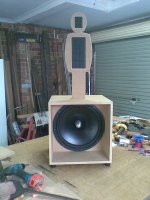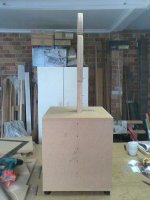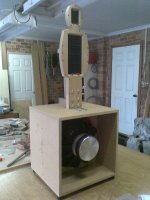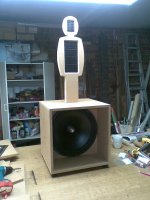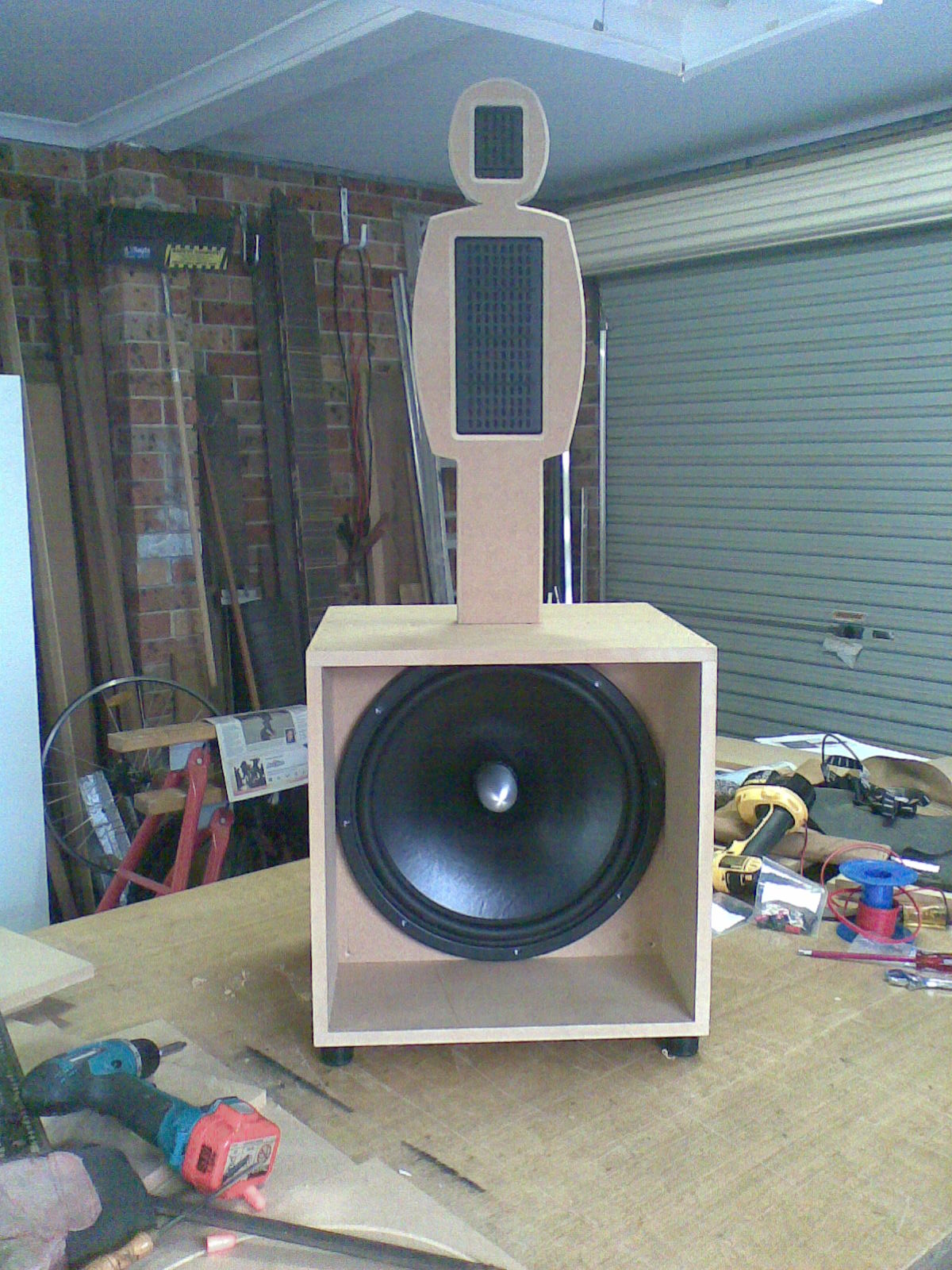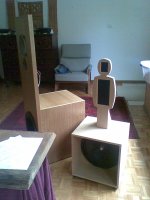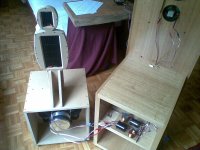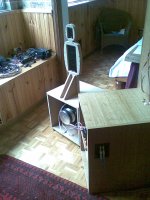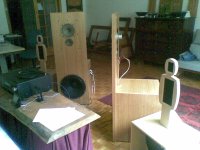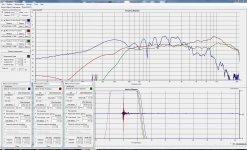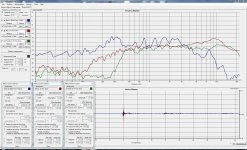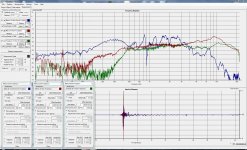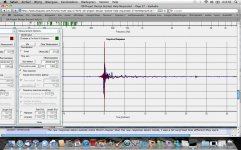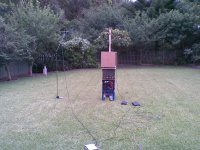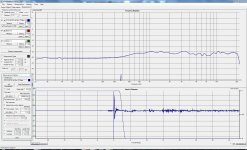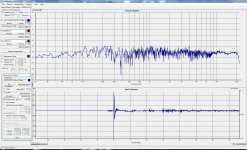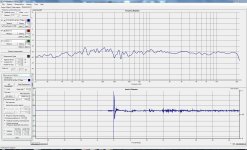It's just the way the design evolved really.
I have purchased a Behringer ECM8000 Mic & a M-Audio Pre Mobile. I have been using HolmImpulse, which seems to be working ok. I will give it a go outside as well to see how if I can get better measurements.
David
In my experience, outside measurements are much more useful especially at the higher frequencies (ie. above 200 Hz) but also for getting the basic response curve right at low frequencies. If you are limited to indoor measurements you probably have to gate your measurements to 3-5ms to get a reasonable understanding of the response by eliminating all the room reflections. I found the in room response measurements more useful for tuning the low frequency response and seeing the effects of room treatments.
Finally
Well the prototype is finished. I have decided to build the other one straight away, so once I sort out the active crossover I can listen to them for a while before I race off & built the real deal, that's assuming the design stacks up.
I have used 16mm MDF for the H frame but will be using 25mm in the final version. The "Man" will be made of some yet unknown hardwood. I also wont have all of the brackets, bolts & wires visible in the final version.
One thing that is a bit odd is the tweeter & mid have the positive terminal on different sides? The mid also had a dob of red on the negative side, I'm wondering if they accidently mixed them up?
Well the prototype is finished. I have decided to build the other one straight away, so once I sort out the active crossover I can listen to them for a while before I race off & built the real deal, that's assuming the design stacks up.
I have used 16mm MDF for the H frame but will be using 25mm in the final version. The "Man" will be made of some yet unknown hardwood. I also wont have all of the brackets, bolts & wires visible in the final version.
One thing that is a bit odd is the tweeter & mid have the positive terminal on different sides? The mid also had a dob of red on the negative side, I'm wondering if they accidently mixed them up?
Attachments
Well the prototype is finished. I have decided to build the other one straight away, so once I sort out the active crossover I can listen to them for a while before I race off & built the real deal, that's assuming the design stacks up.
I have used 16mm MDF for the H frame but will be using 25mm in the final version. The "Man" will be made of some yet unknown hardwood. I also wont have all of the brackets, bolts & wires visible in the final version.
One thing that is a bit odd is the tweeter & mid have the positive terminal on different sides? The mid also had a dob of red on the negative side, I'm wondering if they accidently mixed them up?
Those sub woofers are MASSIVE
 😀. You should perhaps measure front compared to back at some distance to see if the back has slightly higher output level something like U-Frame... I wonder if your baffle should be moved forward a bit??
😀. You should perhaps measure front compared to back at some distance to see if the back has slightly higher output level something like U-Frame... I wonder if your baffle should be moved forward a bit?? 
RE polarity: I've used a AA battery to test speaker polarity with good success....assuming you can see the diaphragm move you can use short wires from battery to make it jump. If positive lead on battery to positive lead on driver makes it jump "forward" (i.e. toward listener) then you know it is labeled right. The voltage is low enough there should be very little risk of damage. 😉
I still think your midrange and tweeter should be closer together.
 Still, it looks very nice.
Still, it looks very nice. 

Those sub woofers are MASSIVE😀. You should perhaps measure front compared to back at some distance to see if the back has slightly higher output level something like U-Frame... I wonder if your baffle should be moved forward a bit??
RE polarity: I've used a AA battery to test speaker polarity with good success....assuming you can see the diaphragm move you can use short wires from battery to make it jump. If positive lead on battery to positive lead on driver makes it jump "forward" (i.e. toward listener) then you know it is labeled right. The voltage is low enough there should be very little risk of damage. 😉
I still think your midrange and tweeter should be closer together.Still, it looks very nice.

Yes I will measure all once I am done building, I may get time on the day after Christmas to finish the second speaker, then it will be the DSP crossover then the measuring🙂
I was wondering about moving the bass forward, I'll see after measuring. It would also help with driver alignment, as the "Man" needs to stay in the middle of the box for aesthetic reasons. At the moment He is slightly towards the rear.
Your right about the tweeter, mid being closer together, but I dont think it will happen🙂 At least not in this version.
Thanks for the input & interest, it's always nice to have some feedback.
Have a Great Christmas & stay safe & warm.
David
Happy Christmas To All
Happy Christmas to all that have helped me with this project & to all who have watched.

May all of you audio dreams come true.
Stay safe & for those in the northern hemisphere, stay warm.
Thanks Heaps
David
Happy Christmas to all that have helped me with this project & to all who have watched.

May all of you audio dreams come true.
Stay safe & for those in the northern hemisphere, stay warm.

Thanks Heaps
David

And Then There Was Two
Well I finished the pair, & because I'm so impatient, I decided to give them a run connected through the crossovers from the P17. They didn't sound too back with a bit of contemporary rock playing & a solo jazz blues singer, but when I put some classical on (which is my main diet) things didn't sound so good.
Too early to judge of course😀
I'll get a chance to get the MiniDSP running in a couple of days, so I will report back then.
David
Well I finished the pair, & because I'm so impatient, I decided to give them a run connected through the crossovers from the P17. They didn't sound too back with a bit of contemporary rock playing & a solo jazz blues singer, but when I put some classical on (which is my main diet) things didn't sound so good.
Too early to judge of course😀
I'll get a chance to get the MiniDSP running in a couple of days, so I will report back then.
David
Attachments
Crossover Help Requested
I have taken measurements of the speakers outdoors at 1m to use to determine the crossover starting point.
I would very much appreciate your input re crossover strategy based on my measurements.
I will be using the MiniDSP for the crossover & EQ
If you would like anything else posted please let me know.
It's amazing how noisy it can be in the backyard, damn that wild life🙂
The raw response taken outside looks MUCH cleaner than the raw response taken inside, I was a bit surprised how different they were.
At his stage I'm thinking of crossing at about 250 & 2500, but have not worked out what to do with the EQ yet, just finished measuring.
David
I have taken measurements of the speakers outdoors at 1m to use to determine the crossover starting point.
I would very much appreciate your input re crossover strategy based on my measurements.
I will be using the MiniDSP for the crossover & EQ
If you would like anything else posted please let me know.
It's amazing how noisy it can be in the backyard, damn that wild life🙂
The raw response taken outside looks MUCH cleaner than the raw response taken inside, I was a bit surprised how different they were.
At his stage I'm thinking of crossing at about 250 & 2500, but have not worked out what to do with the EQ yet, just finished measuring.
David
Attachments
If you would like anything else posted please let me know.
It's amazing how noisy it can be in the backyard, damn that wild life🙂
The raw response taken outside looks MUCH cleaner than the raw response taken inside, I was a bit surprised how different they were.
David
It is easy to measure mid high inside the house. There for you set the gating at about 5msec.
A MLS measurement can discriminate the room response by triggering on the mls signal and stop measuring so the reflection who comes after 5 msec doesn't play a roll in the measured response.
To measure low response you need a longer measuring window 20 msec I would advise. And place the microphone 20cm in front of your sub. This also helps to discriminate the reflections.
To become a good measurement of the hole system. Take it out side and measure it with the microphone on 3 meter distance. Then you see the response of the mixed homogen sound wave the same you get on your listening position.(test it with your first OB)
I made a normal speaker and filterd at 250Hz it sounded thin I later filtered at 400hz with better result sound wise more body.
Choose option impulse time window(gating) set start from -1 for mid high To 5msec, and for low to 20msec.
succes, Helmuth
succes, Helmuth
Attachments
Last edited:
Choose option impulse time window(gating) set start from -1 for mid high To 5msec, and for low to 20msec.
succes, Helmuth
As always, thank you.
David
I forgot to show the setup.
Attachments
Last edited:
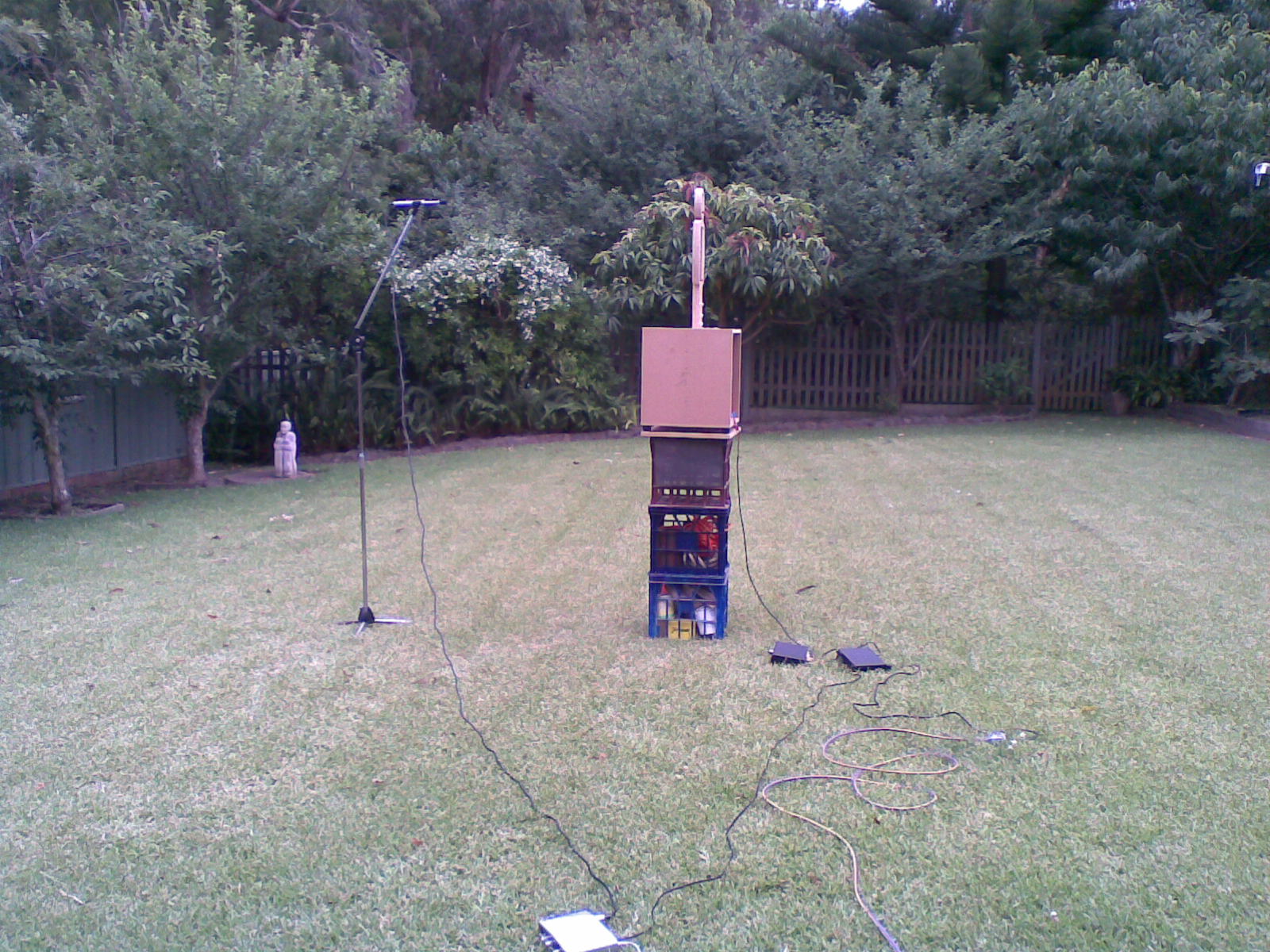
This is the best way to measure without room gain.
But I would measure it on the ground because thats the way it will be used.
No one listens music in a reflection free room. The measurements in a reflection free environment are great to compare responses of drivers. But it is useless in terms of low response in the real listening room.
The great thing of DIY is to optimize the response in your apartment, what with a commercial product would depend on luck.
David,
Very nice and state-of-the-art speakers. The result should be good.
However I would try to totally decouple bass baffle from mid-tweeter baffle, just for sonic purity.
/Erling
Very nice and state-of-the-art speakers. The result should be good.
However I would try to totally decouple bass baffle from mid-tweeter baffle, just for sonic purity.
/Erling
David,
Very nice and state-of-the-art speakers. The result should be good.
However I would try to totally decouple bass baffle from mid-tweeter baffle, just for sonic purity.
/Erling
That's easier said then done😀, I will keep thinking about it so hopefully by the time I ready to built the final version I will have a solution.
David
Some measurements for consideration. The measurements shown are taken in the room the speakers will be in.
They are taken on axis 1m from the speaker.
They are all the same measurement presented in different ways.
1) Gated 2.5ms
2) Raw
3) Smoothed 1-12th
I would much appreciate any thoughts you can give me.
Most people seem to prefer the Gated measurement, but given they are in the room I will be listening to them in, I would have thought the Smoothed & or Raw would be the most informative overall.
Once I get a measurement that I am satisfied with overall, will set them both up in the listening position & do some measurements. Which is a bit tricky since I do my listerning in bed🙂
David
They are taken on axis 1m from the speaker.
They are all the same measurement presented in different ways.
1) Gated 2.5ms
2) Raw
3) Smoothed 1-12th
I would much appreciate any thoughts you can give me.
Most people seem to prefer the Gated measurement, but given they are in the room I will be listening to them in, I would have thought the Smoothed & or Raw would be the most informative overall.
Once I get a measurement that I am satisfied with overall, will set them both up in the listening position & do some measurements. Which is a bit tricky since I do my listerning in bed🙂
David
Attachments
Hi David,
When you gate 2,5msec that means 1sec devided by 2,5msec = 400Hz is the lowest frequency you can measure good.
With 20msec 50Hz.
You do not understand why you use MLS the advantage is you can gate the first recieved sound.Also your ears can do that to some amount (haas effect) you have to understand your hearing to design speakers.
Haas effect - Wikipedia, the free encyclopedia
And with stereo you have a nother fault called combfilter effect. It is a interference effect of two sources, your also have this interference with a multiway loudspeaker in the crossover area and by reflections on the baffle of one driver.
Stereophonic sound - Wikipedia, the free encyclopedia
Comb filter - Wikipedia, the free encyclopedia
MLS has often the ability to filter away the side lobes by a mathematical filter Hamming or Hanning or Keyser. This to improve accuracy of your measurement.
Window function - Wikipedia, the free encyclopedia
It is important to understand what your dealing with.
Succes
When you gate 2,5msec that means 1sec devided by 2,5msec = 400Hz is the lowest frequency you can measure good.
With 20msec 50Hz.
You do not understand why you use MLS the advantage is you can gate the first recieved sound.Also your ears can do that to some amount (haas effect) you have to understand your hearing to design speakers.
Haas effect - Wikipedia, the free encyclopedia
And with stereo you have a nother fault called combfilter effect. It is a interference effect of two sources, your also have this interference with a multiway loudspeaker in the crossover area and by reflections on the baffle of one driver.
Stereophonic sound - Wikipedia, the free encyclopedia
Comb filter - Wikipedia, the free encyclopedia
MLS has often the ability to filter away the side lobes by a mathematical filter Hamming or Hanning or Keyser. This to improve accuracy of your measurement.
Window function - Wikipedia, the free encyclopedia
It is important to understand what your dealing with.
Succes
Last edited:
Hi David,
When you gate 2,5msec that means 1sec devided by 2,5msec = 400Hz is the lowest frequency you can measure good.
With 20msec 50Hz.
You do not understand why you use MLS the advantage is you can gate the first recieved sound.Also your ears can do that to some amount (haas effect) you have to understand your hearing to design speakers.
Haas effect - Wikipedia, the free encyclopedia
And with stereo you have a nother fault called combfilter effect. It is a interference effect of two sources, your also have this interference with a multiway loudspeaker in the crossover area and by reflections on the baffle of one driver.
Stereophonic sound - Wikipedia, the free encyclopedia
Comb filter - Wikipedia, the free encyclopedia
MLS has often the ability to filter away the side lobes by a mathematical filter Hamming or Hanning or Keyser. This to improve accuracy of your measurement.
Window function - Wikipedia, the free encyclopedia
It is important to understand what your dealing with.
Succes
Sooo much to learn, thanks
David
Well I've spent a lot of money & at this stage they are not sounding as good as the P17's which I think sound great.
The new speakers have state of the art speakers, digital crossover's & are run active & measure pretty well, so far.
The P17's have very simple (some people think lacking) passive crossover's, 40 to 55 year old speakers & don't measure as well as the new speakers, but they sound better.
Damn, that wasn't a part of the plan
And I'm using the same amp.
I also have six channels of Coldamp on the way. This could be a very expensive flop.
Don't get me wrong, I'm not giving up yet.
David
The new speakers have state of the art speakers, digital crossover's & are run active & measure pretty well, so far.
The P17's have very simple (some people think lacking) passive crossover's, 40 to 55 year old speakers & don't measure as well as the new speakers, but they sound better.
Damn, that wasn't a part of the plan
An externally hosted image should be here but it was not working when we last tested it.
And I'm using the same amp.
I also have six channels of Coldamp on the way. This could be a very expensive flop.
Don't get me wrong, I'm not giving up yet.
David
Well I've spent a lot of money & at this stage they are not sounding as good as the P17's which I think sound great.
The new speakers have state of the art speakers, digital crossover's & are run active & measure pretty well, so far.
The P17's have very simple (some people think lacking) passive crossover's, 40 to 55 year old speakers & don't measure as well as the new speakers, but they sound better.
Damn, that wasn't a part of the planAn externally hosted image should be here but it was not working when we last tested it.
And I'm using the same amp.
I also have six channels of Coldamp on the way. This could be a very expensive flop.
Don't get me wrong, I'm not giving up yet.
David
Thats what every DIY builder does make a image about how they will sound when they are ready. In your case upgraded sound of what you have with the first OB.
I know the feeling when listening the first time. It is all about a good tonal balance. The new design has al ingredients to make a state of the art sound reproduction. Listen more songs not only the ones that sounded good on the first OB.
Most people like the added higher harmonics of a bad amp or speaker. When they hear clean undistorted sound they mis the humming lows and the whizzing highs.
As I look at the karakteristic of your new OB I would lift the lows till 30Hz and 2-3db louder than the mids. Your tweeter in your old design has a increase of 10dB around 10kHz and certainly that is a big difference with a flat response. A speaker with flat response like I have my self now sound really like life when played on the higher levels when I play mine on normal level I mis freshnes the effect caused by your sensitivety of your ears.
So your first OB tweeter lifts the high frequency like a loudness curve. I measured a pair magnepans OB they had also 10dB increase of loudnes below 150Hz to 30Hz. And also above 50khz there was lift in Spl of 10dB. Sounded great to my ears only the 30hz was some time to loud boomy.
Sensetivety when the line go up the loudness has to be increased to expirence the same levels with 1kHz.
An externally hosted image should be here but it was not working when we last tested it.
Last edited:
As I look at the karakteristic of your new OB I would lift the lows till 30Hz and 2-3db louder than the mids. Your tweeter in your old design has a increase of 10dB around 10kHz and certainly that is a big difference with a flat response.
Saba greencone
SABA 1670-DU-20

- Status
- Not open for further replies.
- Home
- Loudspeakers
- Multi-Way
- OB Project Design Started, Help Requested.
